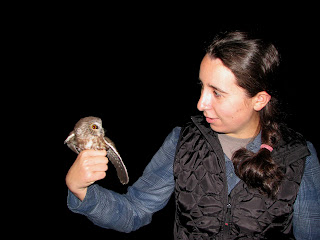Northern saw-whet owls are pretty
much The Cutest Things Ever. This is not an opinion, this is fact. If you look
up “Cutest Thing Ever” in the encyclopedia, it says “See Northern Saw-whet Owl.”
I am not making that up. Okay, maybe I am, but that’s what it should say. As
soon as I’m done with this blog post, I’m modifying the saw-whet Wikipedia
article.
Saw-whets live across most of North
America, and some of them migrate south from Canada to spend the winter in the
mid- to lower United States. Large
concentrations of these owls will migrate around the Great Lakes, which puts
Presque Isle right in the thick of it. Or that’s what we hoped when we set out
to catch a few.
 |
| Northern Saw-whet Owl |
We’d attempted to band saw-whets on
three different nights, and apparently third time’s the try. The set up for
banding owls is somewhat similar to our set up for banding other birds. We
scoped out the best location, which Mattie decided was along the Pine Tree
Trail, closest to the bay side of the park. We set up 6 nets along the trail,
and then to really get the party started we put on a CD called “Hoot-Hoot!! Northern
Saw-whet Party Mix,” a recording of various saw-whet vocalizations (I’m
assuming this is the official name used by researchers). Have you ever listened
to saw-whet calls on repeat for 4+ hours for three evenings? Needless to say, I’m
pretty good with saw-whet calls now.
In addition to our rockin’ music
selection, our banding party also includes hot chocolate, cheese and crackers
(we’re a classy bunch), donuts, and soup. We set up a folding table and chairs
with a lantern and a black-light to really get the mood right, and settle in
for the wait. Every hour, in-between hands of Uno (it gets pretty wild, let me
tell you), we get up and check the nets to see if any owls have been lured in
by our recording.
 |
| 1st saw-whet in the net |
 | ||
| Mattie untangling the 2nd owl |
 |
| Almost out |
The first night we caught a flying
squirrel, which was somewhat exciting (when you’re trying to catch one of The
Cutest Things Ever, anything less is a bit of a let-down). It was not happy to
be our guest, to say the least, and showed its displeasure by chewing a giant
hole in the net. Giant as in I can just about fit through length-wise, and I’m
5’9”. For a creature the size of my palm, this is fairly impressive. This is
also why our owl banding kit includes leather gloves.
Our second attempt yielded nothing,
though we did cut the evening short because a thunderstorm decided to
party-crash. Luckily, we managed to get everything packed up before the
torrential rain put a damper on things. It was on the third try that our
honored owl guests decided to join the party.
 |
| Lauren makes a friend |
These two were actually pretty
early for the party—they arrived in time for our first net-check, around 8:30
p.m., which means they were probably roosting somewhere in the park and had not
flown across the lake that night. If we were catching owls that had just flown
across the border we’d expect them to arrive fashionably later in the evening,
having spent a few hours flying across Lake Erie from Canada.
 |
| We named this one Amy. She was feisty. |
When we catch the owls, we record
the same sort of data as we do for the smaller, less-cute birds we normally
band. We measure the wing chord, weight, and attempt to determine the age and
sex. Sex is determined by size, females having longer wings and higher weights.
To figure out age, we break out the black-light (it wasn’t really for party
atmosphere). If you shine a black-light on the underside of the owl’s wing, the
feathers will glow either pink or purple. Younger owls have a uniform pink
tint, while older owls will have a mix of pink and purple or all purple. How
cool is that? However, what I’m wondering is this: who was the first to figure that out?
 |
| Mattie with our party guest |
Saw-whets are basically fuzzy
little heads with wings and a tail. Their wings are surprisingly long, with a
wingspan of 16.5 to 18.9 inches, dwarfing their tiny bodies. They have feathers
all down their legs and toes, which end in black talons, needle-sharp and tiny
as kitten claws. These talons, though small, can deliver a surprisingly strong
grip, as I found out with the first saw-whet, who had separation anxiety and
wouldn’t let go of my fingers. Imagine a cat with opposable toes gripping into
your nail bed, not quite breaking the skin, but close. It’s almost, but not
quite, painful enough to detract from its cuteness.
 |
| Top view |
Saw-whets eat mainly deer mice, but
are too small to eat an adult mouse in one go. All About Birds says that one owl was found dead after it
apparently tried to swallow a large mouse whole. Researchers don’t actually know
too much about saw-whets because they are hard to study, being nocturnal, shy,
and hard to find.
Another special owl adaptation is
that the leading edges on their flight feathers are fringed, which allows them
to fly silently. When we were ready to send our saw-whet guests on their way,
complete with pretty silver bracelet party-favors, we released them back to the
night. The first one flew from my hand, and if I hadn’t been watching I would
never have noticed it flying away. I blinked and it was gone, absorbed back
into the darkness.
 |
| Mattie and our 1st Owl |
It was a real party on Saturday. Black-lights, drinks,
games, dancing. I have a Happy Owl Dance (it’s very similar to my Snow Day
Dance and my Staying-Warm-While-Waiting-For-The-School-Bus-Because-It-Didn’t-Snow-Enough-To-Cancel-School Dance, only with less foot stomping and more arm
movements).
 |
| Apparently she liked us, because when we were done she didn't want to leave! |
 |
| As soon as I was done taking this picture, she did fly away. (The owl, not Mattie.) |
This is why being a field biologist is so awesome.

